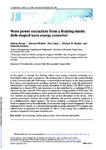Wave power extraction from a floating elastic disk-shaped wave energy converter
| dc.contributor.author | Zheng, Siming | |
| dc.contributor.author | Michele, Simone | |
| dc.contributor.author | Liang, H | |
| dc.contributor.author | Meylan, M | |
| dc.contributor.author | Greaves, Deborah | |
| dc.date.accessioned | 2022-09-13T13:30:00Z | |
| dc.date.issued | 2022-10-10 | |
| dc.identifier.issn | 1469-7645 | |
| dc.identifier.issn | 1469-7645 | |
| dc.identifier.other | A38 | |
| dc.identifier.uri | http://hdl.handle.net/10026.1/19630 | |
| dc.description.abstract |
In this paper, a concept of a floating elastic wave energy converter consisting of a disk-shaped elastic plate is proposed. The floating plate is moored to the seabed through a series of power take-off (PTO) units. A theoretical model based on the linear potential flow theory and eigenfunction matching method is developed to study the hydroelastic characteristics and evaluate wave power absorption of the device. The PTO system is simulated as a discrete PTO, and moreover, it is also modelled as a continuum PTO to represent the case when the PTO system is composed of a large number of PTO units. The continuum PTO approximation is tested against the discrete PTO simulation for accuracy. Two methods are proposed to predict the wave power absorption of the device. After running convergence analysis and model validation, the present model is employed to do a multiparameter impact analysis. The device adopting a continuum PTO system is found to capture wave power efficiently in an extensive range of wave frequencies. For the continuum PTO system, it is theoretically possible to adopt optimised PTO damper and stiffness/mass to guarantee the absorption of 100 % of the energy flux available in one circular component of the plane incident wave. | |
| dc.language | en | |
| dc.language.iso | en | |
| dc.publisher | Cambridge University Press | |
| dc.subject | wave scattering | |
| dc.subject | surface gravity waves | |
| dc.subject | wave-structure interactions | |
| dc.title | Wave power extraction from a floating elastic disk-shaped wave energy converter | |
| dc.type | journal-article | |
| dc.type | Journal Article | |
| plymouth.author-url | https://www.webofscience.com/api/gateway?GWVersion=2&SrcApp=PARTNER_APP&SrcAuth=LinksAMR&KeyUT=WOS:000853094400001&DestLinkType=FullRecord&DestApp=ALL_WOS&UsrCustomerID=11bb513d99f797142bcfeffcc58ea008 | |
| plymouth.volume | 948 | |
| plymouth.publication-status | Published | |
| plymouth.journal | Journal of Fluid Mechanics | |
| dc.identifier.doi | 10.1017/jfm.2022.701 | |
| plymouth.organisational-group | /Plymouth | |
| plymouth.organisational-group | /Plymouth/Faculty of Science and Engineering | |
| plymouth.organisational-group | /Plymouth/Faculty of Science and Engineering/School of Engineering, Computing and Mathematics | |
| plymouth.organisational-group | /Plymouth/REF 2021 Researchers by UoA | |
| plymouth.organisational-group | /Plymouth/REF 2021 Researchers by UoA/UoA12 Engineering | |
| plymouth.organisational-group | /Plymouth/Users by role | |
| plymouth.organisational-group | /Plymouth/Users by role/Academics | |
| dcterms.dateAccepted | 2022-08-09 | |
| dc.rights.embargodate | 2022-9-24 | |
| dc.identifier.eissn | 1469-7645 | |
| dc.rights.embargoperiod | Not known | |
| rioxxterms.versionofrecord | 10.1017/jfm.2022.701 | |
| rioxxterms.licenseref.uri | http://www.rioxx.net/licenses/all-rights-reserved | |
| rioxxterms.type | Journal Article/Review |


